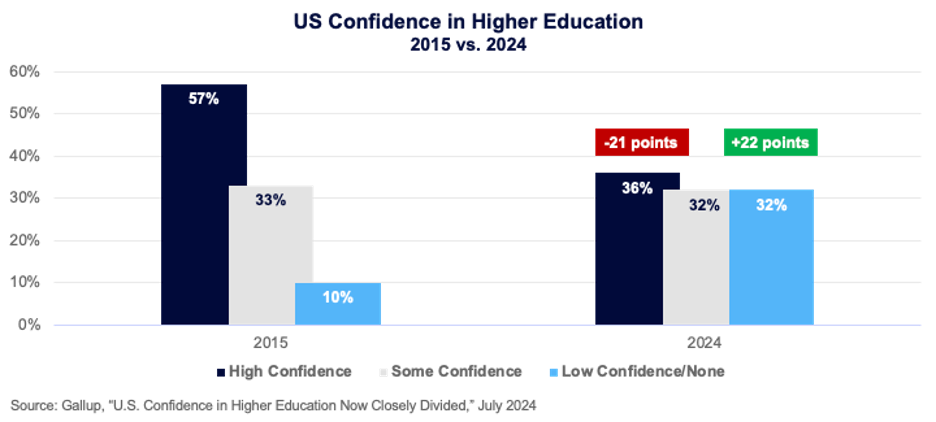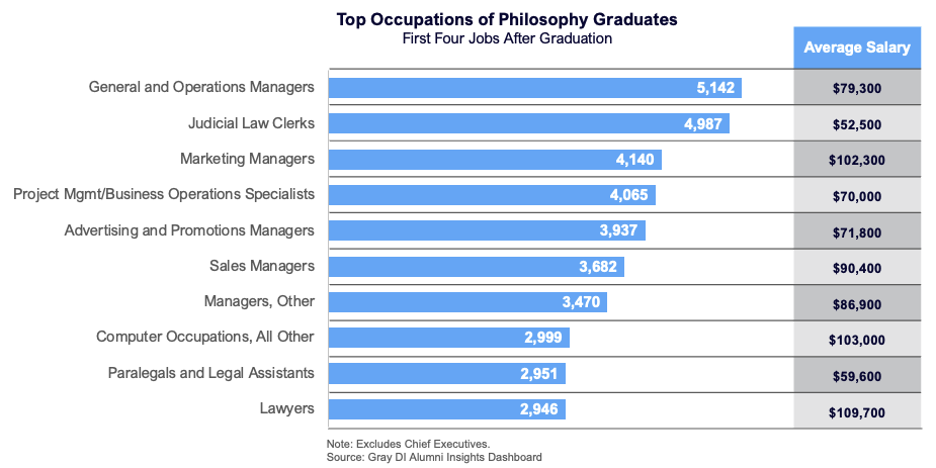Public skepticism about the value of a college degree has intensified in recent years. A 2024 Gallup survey found that the percentage of Americans who have high confidence in higher education dropped 21 percentage points from 2015 to 2024; at the same time, the percentage of Americans with low or no confidence in higher education rose 22 points. How can colleges and universities change the narrative and restore confidence and trust in higher education?

Use Data to Change The Narrative
Transparency and relevance are key to bridging this confidence gap. Communicating with clear and concise data that demonstrates a college education’s tangible benefits and value can help institutions rebuild confidence and trust with the public, prospective students, and stakeholders.
Communicating Value to the Public: Higher Education Delivers for a Lifetime
Several factors contribute to public erosion of confidence in higher education, including rising costs, leading many to question the return on investment of a college degree. However, this perception does not coincide with reality. Various studies have quantified the value of a college degree and show that college graduates earn more over their lifetimes than those with only a high school diploma.
For example, Georgetown University’s Center on Education and the Workforce calculated the median 40-year ROI of a bachelor’s degree to be between $1.4 and $1.8 million. The ROI of an associate degree ranges from $1.3 to $1.4 million.
Further research from the Federal Reserve Bank in New York found that the wage premium for college graduates since 2020 has been about $32,000 annually, or 68 percent higher compared to those with a high school diploma. This premium tends to grow over one’s career, and over a lifetime, the median return on investment for a college graduate is 12.5 percent.
These are just a few examples of how institutions and organizations can use real-world data to communicate the value of higher education to the public.
Communicating Value to Students: Linking Degrees to Careers
Many students considering college may hesitate to enroll in programs because they do not have a clear understanding of what they can do with their degree after graduation.
Indeed, the link between programs and jobs or careers is not always clear-cut. Some programs focused on trades or in fields such as nursing have a relatively direct link to jobs; most nursing majors become nurses, and welding graduates become welders.
For other programs, the link to jobs and careers is less obvious. Schools that provide real-world data and examples showing the employment outcomes and earnings potential associated with their programs can alleviate concerns about perceived value.
For example, a student may be interested in Philosophy but be concerned about their job prospects after graduation. According to the CIP-SOC crosswalk developed by the Bureau of Labor Statistics and the National Center for Education Statistics, a postsecondary professor is the only occupation “available” to Philosophy majors. This job requires additional graduate-level education and has an average salary of $65,200.
But in reality, the jobs open to Philosophy graduates are plentiful and varied. Gray DI’s Alumni Insights Dashboard tracks the career paths of over 70,000 Philosophy majors. The data indicates that these graduates work in a variety of fields with strong earnings potential. Top occupations range from operations, marketing, advertising, and sales managers, to financial analysts, law clerks, paralegals, and lawyers. Graduates work for companies such as Wells Fargo, the US Army, Amazon, Apple, Microsoft, Bank of America, IBM, and the Peace Corps.

Using data to demonstrate the career paths and wages available to graduates of your programs is critical in communicating their value to prospective students and instilling confidence in their enrollment decisions.
Communicating Value to Stakeholders: Evaluating Program Economics and Market Demand
Schools also need to communicate the value of their programs to internal and external stakeholders, including legislators, governing bodies, boards, and administrative leaders.
Some colleges and universities are under pressure from stakeholders to eliminate small or underenrolled programs to reduce costs. Data about program economics can help schools analyze and communicate the value of each program to stakeholders to better inform decisions about the portfolio. This data indicates which programs make money. Interestingly, as the chart below shows, most small programs are margin-positive; broad-based cuts based on program size alone might not save much money—in fact, it risks exacerbating financial pressures by reducing more revenue from tuition than the costs it might save.

Additionally, sharing data about program economics with stakeholders may reveal alternative, less disruptive options for reducing costs, such as trimming course sections rather than cutting entire programs.
At other times, academic leaders need approval to add or expand existing programs. These types of program decisions – and all others for that matter – should be informed by data to objectively evaluate a program’s potential. This includes data about market demand (e.g., student demand, employment opportunities, labor market needs, skills, and competition), enrollment potential (using predictive analytics), faculty needs, and financial implications.
Rebuilding Confidence with Data
To rebuild declining confidence in higher education, institutions must leverage data to communicate the tangible value and relevance of their academic programs. Colleges and universities can change the narrative by providing prospective students with clear evidence of career outcomes and financial returns and using data to inform strategic decisions with internal and external stakeholders. Ultimately, data-informed insights are crucial for demonstrating the lasting benefits of a college degree and restoring trust in higher education.




